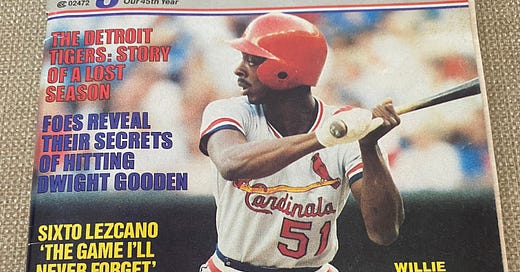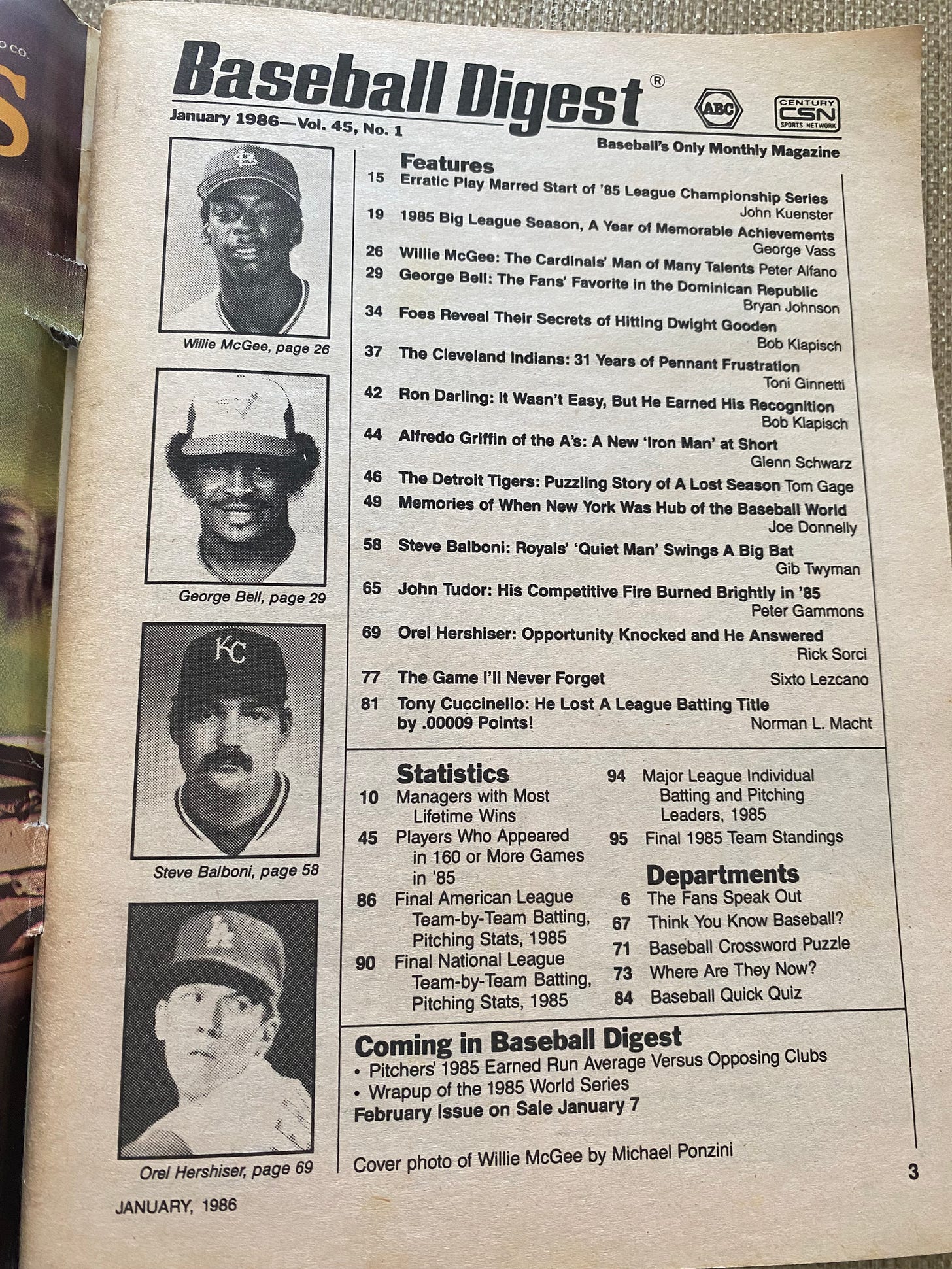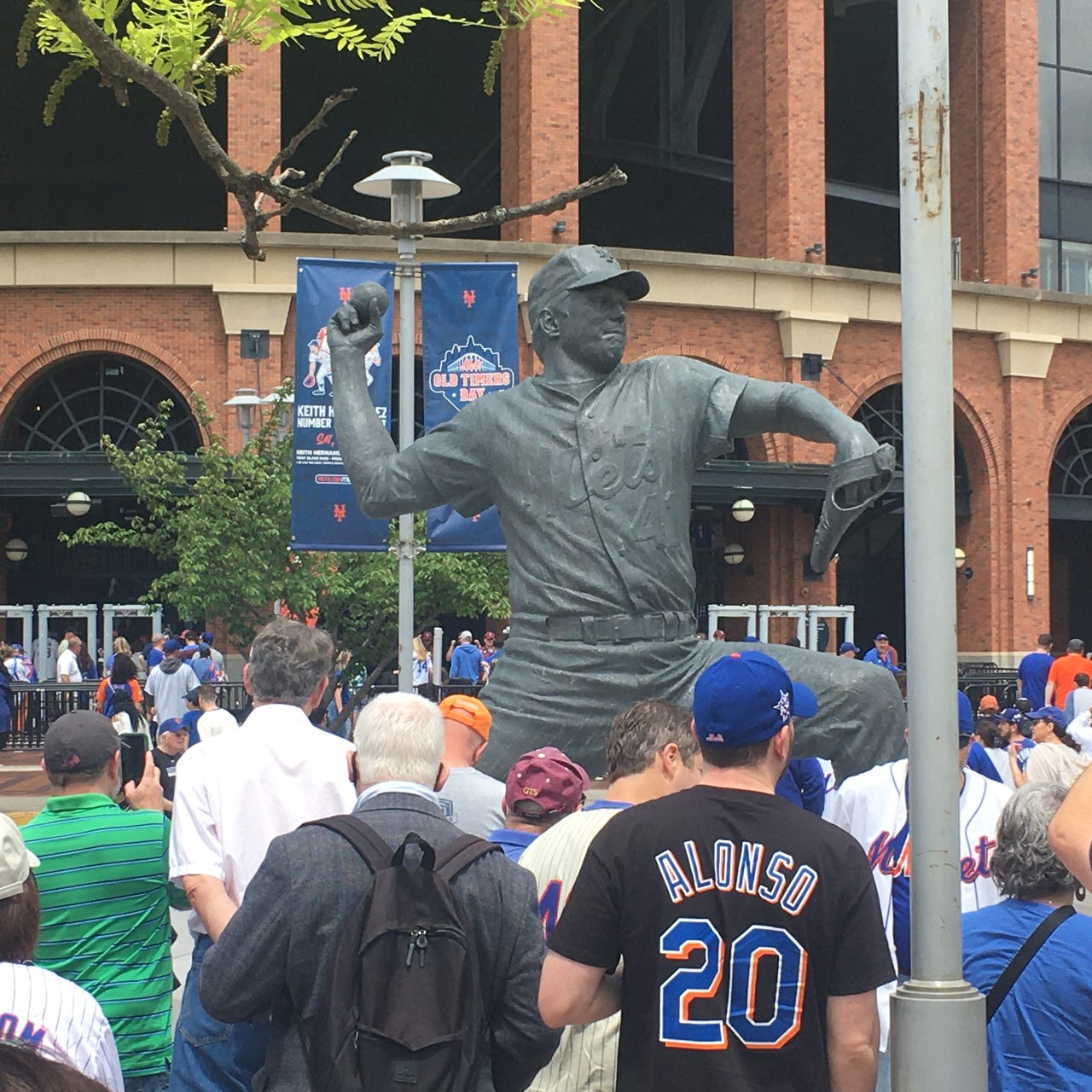January 1986
Much of what I will say is coming from the perspective of Mets fan in me, but much of the content in this issue is at least tangentially related to the man who was the central figure in the 1985 season. ‘85 was the year of Dwight Gooden; he had one of the most dominant pitching seasons in the live ball era, and that is backed up by both traditional statistics and advanced ones. Gooden has a connection to practically every article in the January 1986 issue.
Willie McGee won the NL MVP Award in 1985, and one’s feelings as to whether or not it is deserved is dependent upon whether one feels that pitchers deserve to be considered for the award, which they certainly are by definition. To be clear McGee had an outstanding year, and voters at the time generally gave a built in advantage to the best player on a pennant winning team. I’m not sure if the voting results would have gone the same way today; WAR is not the be all and end all, but Gooden had a WAR of 13.3. That’s not just great; that’s historically great. That’s the type of numbers that one would find with a pitcher who threw 400 innings in a season.
Gooden also outshone two other National League pitchers whose 1985 seasons were so good that they would have been Cy Young front runners in any normal season. Neither John Tudor nor Orel Hershiser had a chance, Gooden received every first place vote. Tudor finished second, Hershiser third, and as a consolation prize each had an article written about them in this issue. Furthermore, Hershiser had a pretty significant season of his own in the near future.
Gooden himself had a spotlight article, but in this case it was not about home per se, but a feature on 4 hitters who had hit well against him. They shared their secrets as to how they “solved” Doctor K. It’s a pet peeve of mine that analysts take such a small sample size and think that it means anything. Of the 4 players, the most at bats that any had against Gooden was Bill Doran, with 21. Is that enough of a sample to suggest that he had Gooden’s number? The other 3, by the way, were McGee, Chili Davis, and Steve Garvey.
If Dwight Gooden was the ace of aces, he also needed a reliable #2 starter in the rotation, and that was Ron Darling. He made for a nice contrast; rather than overpower hitters with the blazing fastball and knee buckling curve that Gooden had, Darling worked the corners. That would work out well in the 1986 season.
Finally, this issue attempted to solve the puzzle of what went wrong with the 1985 Tigers. The ‘84 team led the AL East from wire to wire on the way to winning the World Series without breaking much of a sweat. Things never went their way in 1985; from what I recall there wasn’t much chatter about World Series hangovers back then, but in retrospect it seems like a lot of their relative struggles can be chalked up to exactly that. Several of their pitchers had slight drops in effectiveness, possibly due to still being gassed from the previous year. Much of the core was still present for their return to the playoffs in 1987, but 1984 would prove to be the only title that this edition of the Tigers would win.
Most Memorable Moment - Cincinnati Reds
MLB’s Original 1975 Choice: Johnny Vander Meer’s second consecutive no-hitter in 1938.
My Updated Selection: Pete Rose becomes the hit king.
The Johnny Vander Meer achievement suffers from the lack of accessibility. There is no existing footage of either of his no-hitters, so the feat has grown increasingly abstract over the years. He was still alive in 1975, as were many of the other participants in either or both games, which meant there were plenty of witnesses available to talk about the games. That’s not the case anymore. No one will ever match, let alone surpass, the back to back no hitters. But it’s difficult to fully keep the moment alive if we can’t press a button to punch up clips.
The Big Red Machine are one of the most famous teams in league history, yet I would be hard pressed to come up with one signature moment from their championship run. Instead, I would need to flash forward a decade to a moment which at least featured one of the central players from that team. Knowing how complicated Pete Rose’s legacy is, it almost seems fitting that the achievement which qualifies as the most memorable Reds moment isn’t necessarily as it seems.
Official record keeping in baseball’s early era was not always completely accurate. Later research has revealed inaccuracies on occasion, one of which involved Ty Cobb’s career hits record. Researchers had discovered that two of Cobb’s hits had been counted twice, therefore his career total should have been 4,189, not the 4,191 that had been in the record books. MLB was slow to react to this knowledge, so as Rose was approaching Cobb’s record the official league record still listed Cobb’s incorrect total.
Which means that Pete Rose actually broke the record 3 days earlier than that of the moment with which we are familiar. (I suppose if you want to be overly pedantic it’s technically accurate that he broke the record with this hit against Eric Show. Rose broke his own record, and every hit of his until the end of his career was a new record breaker.) For drama’s sake hit #4,192 is the memorable one. Rose hit 4,190 against Reggie Patterson of the Cubs; Patterson is off the hook when it comes to being on the other side of history. No such luck for Eric Show.
One of the enduring images of the moment is Show’s petulance upon giving up the hit. A lot of jokes emerged concerning the fact that Show was a member of the John Birch Society. Of course he was angry, he was beaten by a Red.
It’s also true that Rose’s march towards the record was a bit of a slog. In 1985 not only was he no longer a great hitter, he was also a net negative. WAR was not yet a thing, but his retroactive WAR numbers in the final seasons of his career fell into negative numbers. That’s not rewriting history either. Even at the time people understood that he was a singles hitter with no speed. A guy with an OPS in the .600’s clogging up the basepaths when he did manage to get on base was no asset. In fact, the only reason he was able to break Cobb’s record was that Rose was fortunate enough to play for the manager in the league willing to give him the playing time that he needed. That outlier of a manager was Rose himself.
No need to get into the other stuff concerning Pete Rose, which is a lot. This is meant to celebrate historic moments, and breaking such a long standing record qualifies. It also helps that the record breaking hit took place in Cincinnati, and that Rose himself was a Cincinnati native and arguably the single biggest franchise icon. Setting the hits record is the most memorable Reds moment.
50 Years Ago - Night Moves
When Gene Hackman recently died, there were all sorts of reminiscences concerning his greatest movies and performances. In addition to the obvious choices almost all of those career retrospectives were sure to mention Night Moves. It likely ranks right up there with The Conversation as the most representative example of Hackman’s particular skill set. He was the everyman whose hubris caused him to lean too far over his skis, resulting in his landing in deep doodoo.
Night Moves was a modern update of classic film noir, and it contained many of the classic tropes of the genre. Hackman portrayed a private eye who has Seen A Lot Of S***. He got involved in a seemingly straightforward case which was More Than It Seemed. There was a femme fatale. And, spoiler alert, things do not end well.
Like many great noirs, the plot specifics could get a little convoluted. The atmosphere is more important than anything else. That is the underlying theory behind Hitchcock’s MacGuffin. If the storytelling is compelling enough, the what supersedes the why. Hackman’s Harry Moseby is a former NFL player turned detective who worked in the periphery of the movie business, more specifically in a grimy, low rent segment of the industry. The expository part of the movie indicates that some of the people in his radar were involved in the smuggling of artifacts. James Woods was a standout as a helicopter mechanic. A young Woods had a great talent for portraying utter sleazebags. Make of that what you will.
The plot moved forward when Hackman was hired by an aging actress to track down her missing teenage daughter - played by a young Melanie Griffith. He finds her in South Florida and this drives him further into the weeds of the smuggling ring. There is much peeling of the layers of the onion to come.
As I mentioned, atmosphere and character are just as important as plot is. It’s noteworthy that early on in the movie Hackman learns that his wife has been having an affair. He’s largely non plussed about the news, and his initial encounter with the other man is not as confrontational as one would expect. He instead used the news as an excuse to generally menace the man rather than physically intimidate him.
Night Moves is a great example of what made so many American movies from the 1970’s so special. It borrowed elements from the movies of the past while instilling modern day mores along with the paranoia of the time into the mix. And no spoilers, but the final shots in the movie might as well be accompanied by a flashing alarm reading “Metaphor! Metaphor!”
Closing Laughs
Easter fell on 4/20 this year, which may or may not have resulted in an increase in sightings of 6 foot tall bunny rabbits. Thanks as always for tuning in, and we will talk again on Wednesday.






